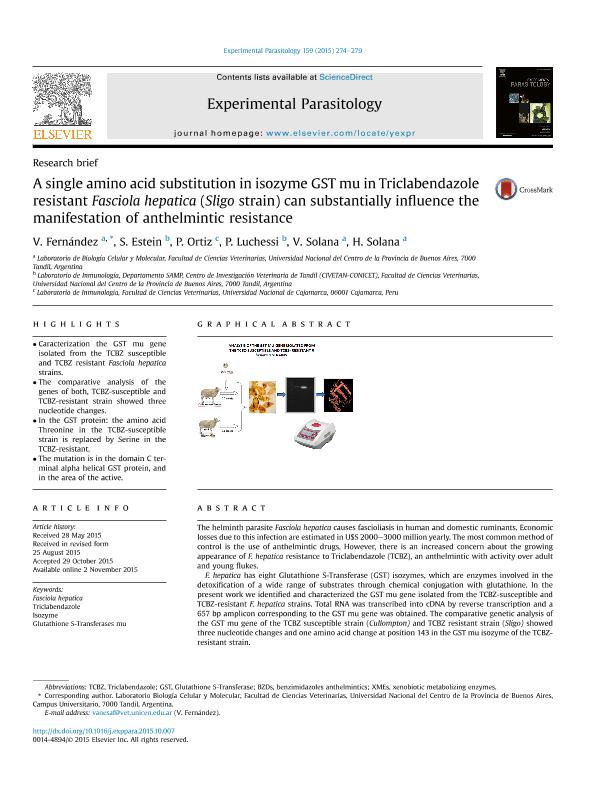Artículo
A single amino acid substitution in isozyme GST mu in Triclabendazole resistant Fasciola hepatica (Sligo strain) can substantially influence the manifestation of anthelmintic resistance
Fernández, V.; Estein, Silvia Marcela ; Ortiz, P.; Luchessi, P.; Solana, María Victoria
; Ortiz, P.; Luchessi, P.; Solana, María Victoria ; Solana, Hugo Daniel
; Solana, Hugo Daniel
 ; Ortiz, P.; Luchessi, P.; Solana, María Victoria
; Ortiz, P.; Luchessi, P.; Solana, María Victoria ; Solana, Hugo Daniel
; Solana, Hugo Daniel
Fecha de publicación:
12/2015
Editorial:
Academic Press Inc Elsevier Science
Revista:
Experimental Parasitology
ISSN:
0014-4894
Idioma:
Inglés
Tipo de recurso:
Artículo publicado
Clasificación temática:
Resumen
The helminth parasite Fasciola hepatica causes fascioliasis in human and domestic ruminants. Economic losses due to this infection are estimated in U$S 2000-3000 million yearly. The most common method of control is the use of anthelmintic drugs. However, there is an increased concern about the growing appearance of F. hepatica resistance to Triclabendazole (TCBZ), an anthelmintic with activity over adult and young flukes.F. hepatica has eight Glutathione S-Transferase (GST) isozymes, which are enzymes involved in the detoxification of a wide range of substrates through chemical conjugation with glutathione. In the present work we identified and characterized the GST mu gene isolated from the TCBZ-susceptible and TCBZ-resistant F. hepatica strains. Total RNA was transcribed into cDNA by reverse transcription and a 657 bp amplicon corresponding to the GST mu gene was obtained. The comparative genetic analysis of the GST mu gene of the TCBZ susceptible strain (Cullompton) and TCBZ resistant strain (Sligo) showed three nucleotide changes and one amino acid change at position 143 in the GST mu isozyme of the TCBZ-resistant strain.These results have potential relevance as they contribute better understand the mechanisms that generate resistance to anthelmintics.
Palabras clave:
Fasciola Hepatica
,
Glutathione S-Transferases Mu
,
Isozyme
,
Triclabendazole
Archivos asociados
Licencia
Identificadores
Colecciones
Articulos(CIVETAN)
Articulos de CENTRO DE INVESTIGACION VETERINARIA DE TANDIL
Articulos de CENTRO DE INVESTIGACION VETERINARIA DE TANDIL
Citación
Fernández, V.; Estein, Silvia Marcela; Ortiz, P.; Luchessi, P.; Solana, María Victoria; et al.; A single amino acid substitution in isozyme GST mu in Triclabendazole resistant Fasciola hepatica (Sligo strain) can substantially influence the manifestation of anthelmintic resistance; Academic Press Inc Elsevier Science; Experimental Parasitology; 159; 12-2015; 274-279
Compartir
Altmétricas



